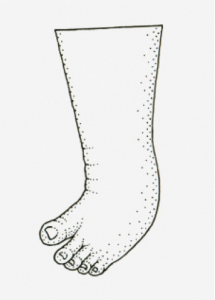Intoeing and Outtoeing
 What is in-toeing?
What is in-toeing?
In-toeing (also known as Pigeon toe) refers to the manner in which feet are turned inward while walking as opposed to pointing straight. This condition is more common in children, particularly females. It often results in tripping and is quite apparent by four years old. In a large percentage of cases, in-toeing is a variation of normal lower extremity development that improves spontaneously with time. If it persists however, you should seek out the help of a foot and ankle specialist.
Causes
By far the most important factor in treating an in-toeing walking pattern is understanding where the inward rotation coming from. The rotation can occur at the hip, thigh bone (femur), leg bone (tibia), and foot.
What is out-toeing?
Out-toeing refers to the manner in which feet are turned outward while walking, versus pointing straight. This is much less common than in-toeing. Similar to in-toeing, most patients out-toeing does resolve with time as it is a normal variation in lower extremity development. However, if it persists through childhood it is important to see a foot and ankle specialist.
Causes
Like in-toeing, it is important to understand the source of the rotation to best treat it. The rotation can stem from the hip, femur, tibia or foot. Rarely is surgery ever indicated to fix this type of problem.